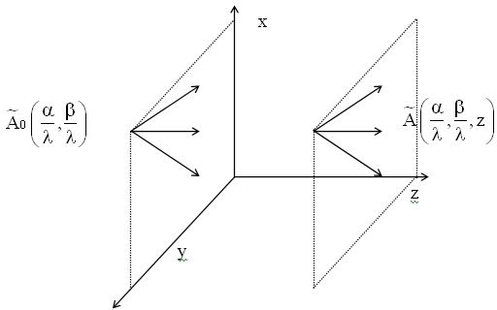
Propagation of the angular spectrum
Let us consider the angular spectrum of a wave U located at a distance z along the propagation axis (see figure II-2) :

To characterize the effects of wave propagation on the perturbation angular spectrum, we need to determine the relation between
 and
and
 . We know that U(x,y,z) can be written under the form of a TF-1 :
. We know that U(x,y,z) can be written under the form of a TF-1 :
In addition, U must follow the Helmholtz equation at any point where there is no source. By replacing (II-10) in (II-9) and after calculation, we find that
 must satisfy the following differential equation [] :
must satisfy the following differential equation [] :
An elementary solution to this equation can be written as:
-
This result shows that when the direction cosines satisfy the inequality
 , the effect of propagation on a distance z translates into a simple phase shift of the various angular spectrum components.
, the effect of propagation on a distance z translates into a simple phase shift of the various angular spectrum components.
-
In the (rarer) case where the direction cosines verify
 (for example in the presence of a diopter), the square root is imaginary and the previous relation can be written:
(for example in the presence of a diopter), the square root is imaginary and the previous relation can be written:
Since μ > 0, the spectral components are attenuated by the propagation phenomenon. Those spectral components are called “evanescent waves”.
-
The borderline case where
 corresponds to waves propagating perpendicularly to Oz. Consequently, they transport no energy along the z axis.
corresponds to waves propagating perpendicularly to Oz. Consequently, they transport no energy along the z axis.